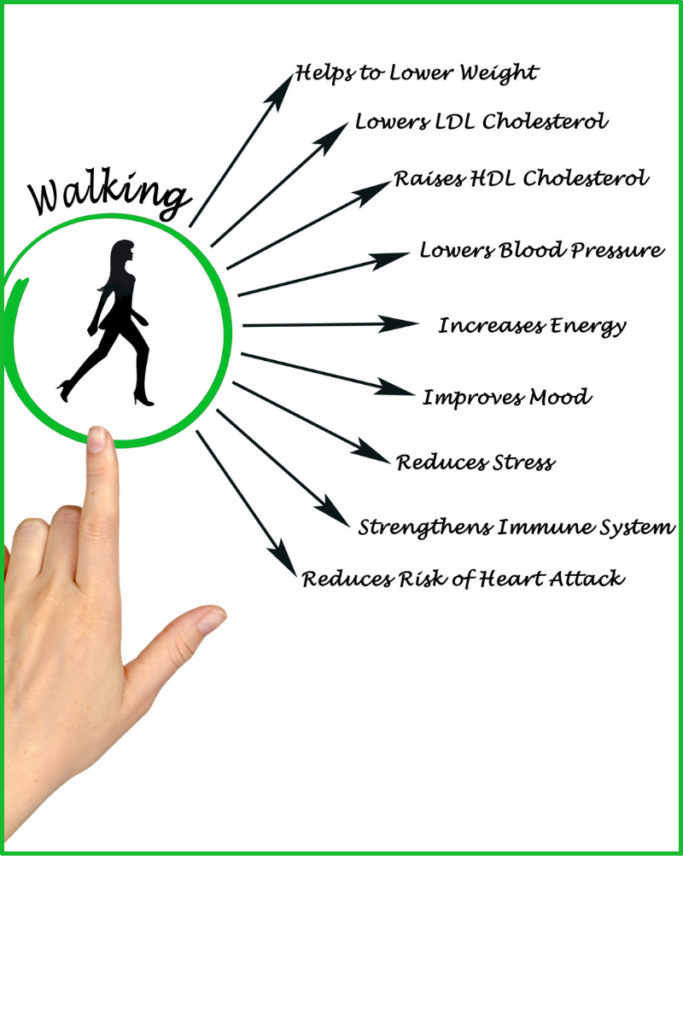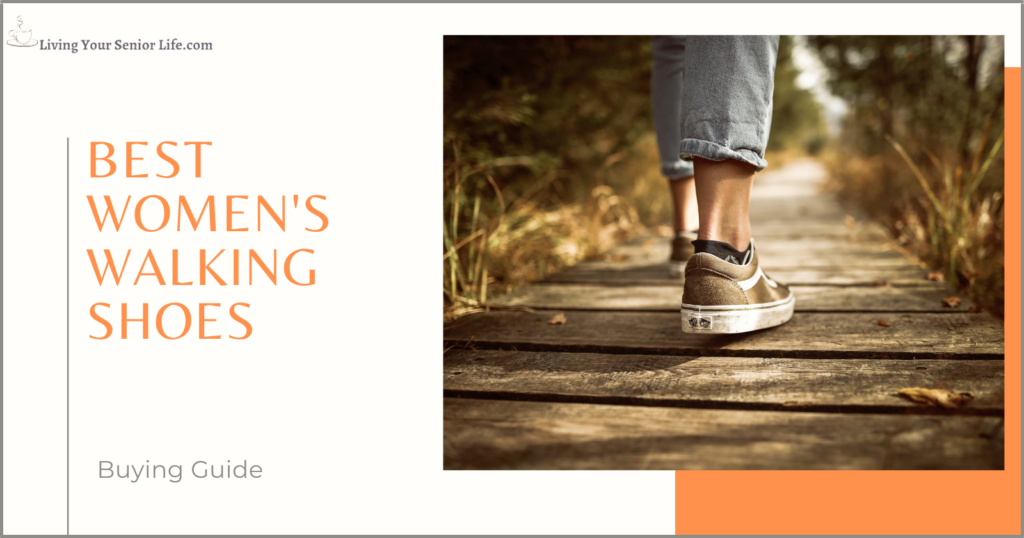Walking is one of the easiest and most accessible forms of physical activity. It requires no special equipment, no gym membership, and can be done anywhere at any time. The Benefits of Walking Daily are numerous for both physical and mental health. So what are you waiting for? It’s easy to get your walk on – lace up your shoes and head out the door!
Key Takeaways:
- Walking daily can improve physical health by reducing the risk of chronic diseases, improving cardiovascular fitness, and strengthening bones and muscles.
- Walking can also have mental health benefits, such as reducing stress and anxiety, improving mood, and boosting self-esteem.
- Creating a walking routine can be a simple and effective way to incorporate physical activity into your daily life.
Video: Benefits of Walking Daily
What Are Some Walking Daily Benefits?

Walking is a safe and inexpensive form of exercise, and just 30 minutes each day provides many health benefits for your physical and mental health. Whether you’re doing it for fun, as a way to lose body weight, and body fat, or as a healthier alternative to taking the bus or riding a bike, a walking workout is an excellent form of daily exercise.
The Physical Health Benefits of Walking Daily Include:
- Improved Cardiovascular Health
- According to the American Heart Association, walking can help lower your risk of heart disease and stroke by reducing blood pressure and cholesterol levels.
- Reduces the risk of heart attack and stroke – regular walking for 30 minutes a day reduces the risk of ischaemic heart disease by up to 37%.
- Additionally, walking can improve your heart health by increasing your heart rate and strengthening your heart muscle.
- Weight Loss/ Increased Fitness Level’Healthier Heart
- Walking is an effective way to manage your weight. By walking regularly, you can burn calories and maintain a healthy weight.
- Walking for just 30 minutes every day can reduce the risk of obesity by 13-25%.
- According to the Physical Activity Guidelines for Americans, adults should aim for at least 150 minutes of moderate-intensity aerobic activity per week to maintain a healthy weight.
- Less Risk of Developing High Blood Pressure
- Walking at least 30 minutes a day reduces the risk of high blood pressure and heart disease, as it increases “good” cholesterol levels while reducing the risk of blood clots.
- Boosting Immune Function
- Walking can also boost your immune function. By walking regularly, you can improve your body’s ability to fight off infections and diseases. Walking can also help reduce inflammation in the body, which can improve overall immune function.
- Reduced Risk of Developing Chronic Diseases
- Walking can help prevent chronic diseases such as cancer and type 2 diabetes. According to the American Diabetes Association, walking can help lower blood sugar levels and improve insulin sensitivity, which can reduce the risk of developing type 2 diabetes.
- Walking just 30 minutes a day can lower the risk of diabetes by around 20%.
- Additionally, walking can help reduce the risk of developing certain types of cancer.
- Strengthening Bones and Muscles
- Walking helps maintain muscle and bone strength and flexibility, which may help prevent painful movements that can lead to arthritis.
- Improved Balance
- Which can reduce the risk of falls.
Mental Health Benefits of Walking Daily
- Better Stress Response
- Walking can help you reduce stress and anxiety levels.
- When you walk, your body releases endorphins, which are natural chemicals that make you feel good. Endorphins can help you relax and feel less anxious.
- Walking can also help you clear your mind and focus on the present moment, which can reduce tension and stress.
- Better Sleep
- Exercise can boost the effect of natural sleep hormones such as melatonin.
- When you walk, your body temperature increases, and this can help you fall asleep faster and stay asleep longer.
- Walking can also help you reduce stress and anxiety, which can interfere with sleep.
- If you walk regularly, you may notice that you feel more rested and refreshed when you wake up in the morning.
- Boosting Cognitive Function
- Walking can improve your cognitive function and memory.
- Walking can increase blood flow to your brain, which can help you focus and think more clearly.
- Walking can also help you improve your creativity and problem-solving skills.
- If you walk regularly, you may notice that you feel more alert and focused throughout the day.
- Boost In Mood and Reduced Risk of Depression
- Walking increases feel-good chemicals that may help fight off depression and anxiety disorder.
- Stay Connected With Friends and Family
- It’s easy to incorporate into your daily routine – just try setting aside time for your walk each day. You can also take your kids or a friend with you to enjoy some quality time together and get active in the process!
Who Can Benefit From Walking?
Walking is good for all age groups, including older adults. For older adults with arthritis, walking can be a gentle way to manage their symptoms, but it’s important to consult your doctor about the best type of exercise for you. Seniors age 65 and older should get at least 2.5 hours of moderate aerobic exercise (such as brisk walking) every week. That averages out to about 30 minutes on most days of the week.
You May Be Interested In Reading: Celebrate National Senior Health and Fitness Day
The Basics of Walking Daily
Walking is a simple and effective way to incorporate physical activity into your daily routine. It is a low-impact exercise that can be done almost anywhere and at any time. By walking for just 30 minutes a day, you can improve your overall health and well-being.
It is important to aim for a moderate-intensity walking pace, which means walking at a pace where you can still carry on a conversation but are slightly out of breath. This will ensure that you are getting the most health benefits from your walking routine. But at the same time you want to go at your own pace and build up slowly.
One of the best times to go for a walk is in the morning. This can help to kickstart your metabolism and provide you with energy for the day ahead. However, you can also fit in walks during your lunch break or after dinner.
Creating a Walking Routine

Walking is a great way to improve your health, but it can be hard to know where to start. Creating a walking routine can help you stay motivated and make it easier to stick to your goals. Here are some tips for creating a walking routine that works for you.
Setting Goals
Before you start your walking routine, it’s important to set some goals. This will help you stay motivated and track your progress. Start by setting a goal for how often you want to walk each week. You might start with just a few days a week and work your way up to walking every day.
You can also set goals for how long you want to walk each day or week. For example, you might start with a 10-minute walk and work your way up to 30 minutes or more. You can use a pedometer or fitness tracker to track your steps and distance.
It’s also worth mentioning that it might be good to schedule your walks around the time you find it easier to be active – for instance, early morning or before dinner.
Choosing the Right Gear

Choosing the right gear is important for a comfortable and safe walking experience. Make sure you have comfortable shoes with good support. Walking shoes are specifically designed for walking and can help prevent injuries.
You might also want to consider wearing sunscreen and a hat to protect yourself from the sun. If you’re walking in the dark, wear reflective clothing or carry a flashlight.
Planning Your Route
Planning your route ahead of time can help you stay motivated and avoid getting lost. You might want to choose a route that includes scenic views or interesting landmarks. You can use a map or a walking app to plan your route.
Incorporating Variety
Walking the same route every day can get boring. Incorporating variety into your walking routine can help keep it interesting. You might try walking in different locations or changing your route. You can also listen to music, podcasts, or audiobooks to keep yourself entertained.
Walking with Others
Walking with others can make your walking routine more fun and social. You can walk with a friend, family member, or join a walking group in your community. Walking with others can also help you stay motivated and accountable.
By following these tips, you can create a walking routine that works for you and helps you achieve your health goals.
Walking Safety and Precautions
Walking is generally a safe and low-impact form of exercise, but it’s still important to take certain precautions to ensure your safety and prevent injuries. Here are some tips to keep in mind:
Preventing Injuries
- Wear comfortable shoes with good arch support and cushioning to prevent foot and ankle injuries.
- Start with a slow and gentle warm-up, such as walking at a slower pace for the first few minutes, to prepare your muscles and joints for more intense activity.
- Gradually increase your walking speed and distance over time to avoid overuse injuries.
- Use proper form when walking, keeping your head up, shoulders back, and arms swinging naturally at your sides. Avoid slouching or hunching over, which can strain your neck and back.
- If you have any pre-existing medical conditions or injuries, consult with your healthcare provider before starting a walking program.
Maintaining Hydration
- Drink plenty of water before, during, and after your walk to stay hydrated. Aim for at least 8-10 glasses of water per day, and more if you’re walking in hot or humid weather.
- Consider carrying a water bottle with you on your walk, or plan your route to include water fountains or rest stops where you can refill.
Dealing with Weather Conditions
- Dress appropriately for the weather, wearing lightweight, breathable clothing in hot weather and layers in cold weather.
- Avoid walking during extreme weather conditions, such as thunderstorms or high winds, which can be dangerous. Check the weather forecast before heading out.
- If you’re walking in hot weather, try to walk during the cooler parts of the day, such as early morning or late evening. Wear a hat and use sunscreen to protect your skin from the sun’s harmful rays.
Tips For Beginners
Remember not to worry about how fast or far you’re going at first; just get your body moving and enjoy yourself. It’s recommended that you walk for at least 10 minutes each day to see results, but more is okay too! Here are some tips to follow if you’re a beginner:
- Start walking with manageable goals
- Walk at a safe pace before increasing to a brisk walk or hill walking
- Wear comfortable clothes and shoes
- Take along a buddy (2 or 4 legged) if you can or join a walking group
- Make time for your walk and treat it as an important part of your day
- Give yourself lots of praise and encouragement along the way!
Tips For Making Your Walk More Enjoyable
Here are some tips for making your walk more enjoyable:
- Listen to podcasts or music
- Spend time in nature
- Meet up with friends
- Take a friend who enjoys walking too!
By following these safety and precautionary measures, you can enjoy the many benefits of walking while minimizing your risk of injury or discomfort.
How Much Should I Walk?

The National Heart, Lung, and Blood Institute recommends that adults get at least 150 minutes of moderate physical activity each week – this can be broken up into smaller sessions throughout the day. You should also aim for at least two days of strength training each week. Remember to check with your doctor before starting an exercise routine if you’ve been inactive recently – they can help you come up with a good plan for getting started!
Does Walking Have Any Risks?
There is always the possibility of injury while doing any physical activity. When beginning to walk for activity keep your age and fitness level in mind. Be sure to start slow and build up your distance and walking speed as you become more comfortable with walking, and if you have any joint problems or health issues, be sure to check with a doctor before starting a new exercise routine.
FAQs
How does walking daily affect weight loss?
Walking daily can help with weight loss by burning calories. The number of calories burned during walking depends on various factors, such as walking speed, distance, and body weight. According to Verywell Fit, walking five miles a day can burn up to 500 calories. However, weight loss is not just about burning calories. It also involves a healthy diet and lifestyle. Walking can be a great addition to a weight loss plan, but it should not be the only method relied upon.
What is the recommended duration of walking daily?
The recommended duration of walking daily varies depending on your fitness level and goals. According to the Centers for Disease Control and Prevention (CDC), adults should aim for at least 150 minutes of moderate-intensity aerobic activity, such as brisk walking, per week. This can be broken down into 30 minutes of walking per day, five days a week. However, if you are just starting, it is recommended to start with shorter walks and gradually increase your duration and intensity.
How soon can I expect to see results from walking daily?
The results of walking daily can vary depending on various factors, such as your starting fitness level, diet, and lifestyle. According to Healthline, walking can have immediate benefits, such as improved mood and energy levels. However, visible changes in weight and body composition may take longer to appear. Consistency is key when it comes to seeing results from walking daily. It is recommended to make walking a regular habit and combine it with other healthy habits for best results.
Related Articles
Conclusion
Walking is one of the easiest and most effective ways to improve your overall health. By walking regularly, you can enjoy a wide range of benefits that can help you feel better both physically and mentally.
The benefits of walking daily are numerous. Walking can help you maintain a healthy weight, improve your cardiovascular health, and reduce your risk of chronic diseases such as diabetes, heart disease, and stroke. It can also help you improve your mood, reduce stress and anxiety, and boost your overall sense of well-being.
In addition to these health benefits, walking is also a great way to stay active and social. Whether you prefer to walk alone or with a group, walking can be a fun and enjoyable way to stay active and meet new people.
Overall, walking is an excellent way to improve your health and well-being. By making walking a regular part of your routine, you can enjoy all of the benefits that this simple and effective exercise has to offer. So why not start walking today and see how it can help you feel better both inside and out?
Is there a way that walking has improved your life? Let us know by leaving a comment – we’d love to hear.










